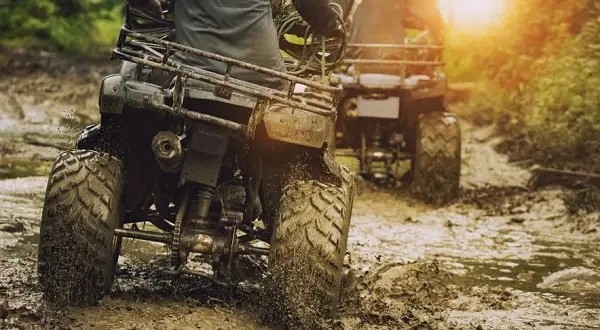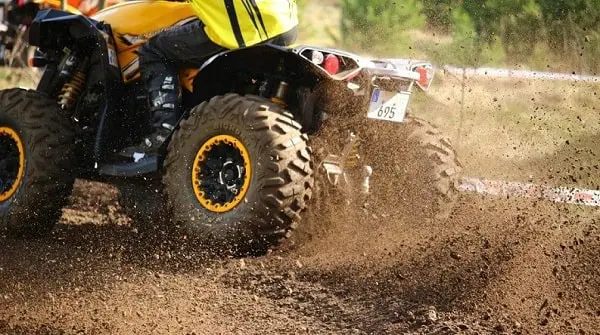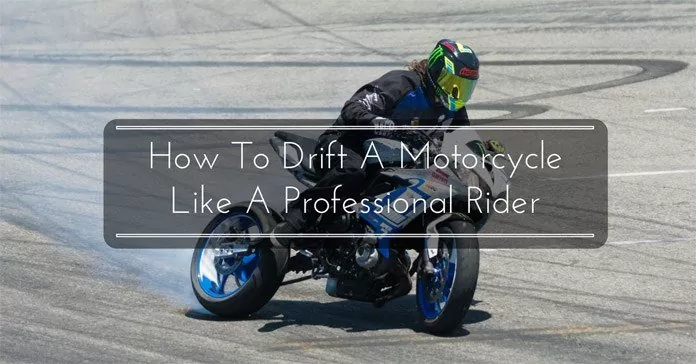Learning how to drift a motorcycle can be compared to learning to ride a bike: it’s something that can take time to master, but once it’s mastered will provide you with unlimited excitement and adrenaline rushes.
Just like riding a bike, you will make mistakes, but the question is whether you will grow and learn from those mistakes or keep the training wheels on your bike out of fear.
Exactly how keen are you when it comes to learning how to drift motorcycle? This article is designed to help you learn how to drift, and if followed correctly, with a bit of practice you will be drifting in no time! It’s how I learned how to drift, and I’m sure you can too.
Here is a drifting display of a professional rider:
What you’ll need to learn how to drift a motorcycle.

The act of drifting doesn’t necessarily require much more than a motorcycle. I would however always encourage you to wear your protective gear, especially your helmet. This is a dangerous task and you should only do it if you are prepared and already have a little experience riding a motorcycle.
To successfully and safely drift your motorcycle, you may need:
Too much or too little protective gear can result in injury, and it is recommended you find what’s best for you, although the above are the ideal bare minimum. Additionally, side armor for your bike is a must have as it will protect your bike from scraping the ground and causing damage. Always make sure your bike is in good
Working condition before attempting to drift by getting it serviced. It’s not uncommon for motorcycle accidents to happen because of faulty bikes.
Instructions
1. Build your riding confidence.
Your first experience on your motorcycle probably won’t be a smooth one. Drifting will be even less of a pleasant experience, especially for first-timers.
To build your confidence on the bike, you need to practice as much as you can. This can be riding around your home, or a safe place where people know where you are in case of an emergency. It doesn’t have to be fancy, but just enough space to drift without crashing into something.
You need to dress for comfort not style, and possibly (and highly recommended) take a riding class before trying to drift. This will give you immediate experience and let you learn from the mistakes of others, and not have to go through it yourself. You can also have first-hand mentoring from professionals to get you on the right track.
2. Start slowly.
When drifting, you want to start slowly. Eventually, you need to build momentum with your bike at a comfortable pace to begin your drift. Drifting isn’t about speed, it’s about skill. I want to remind you that drifting can be dangerous even for professionals, and you should always be wearing protection when around the vehicle.
The last thing we don’t want to hear is your injury just because you didn’t wear necessary protective gear when drifting. Make sure you train on clean asphalt for optimum drifting potential and have no risk of serious injury.
3. Learn How To Rear Wheel Break.
When drifting, you need to first learn how to break your back wheel when riding at 15-20km/h. This should initially be done slowly, but once the clutch has been pulled come to a hard-rear wheel break.
This is the easiest part of drifting, but can be daunting for beginners. It may take a couple of attempts before done smoothly but remember there is no pressure for you to master this in your first attempt or even your first 100 attempts.
4. Learn to do a 90-120 degree skid at the end of breaking distance.
Once you have mastered breaking from the rear wheel, you’ll be faced with your next step. This is where it gets tricky, and you’ll have to turn between 90 and 120 degrees at the end of your skid. It’s important this is done at the end and not at the start or in the middle, as you will be going too fast and will lose balance if maneuvered at too fast of a pace.
Once you’ve got this down, you’ve got the hard part out of the way and now the fun begins with the next step.
5. Rear wheel slippage.
The next step is to learn how to rear wheel slippage, and after the 90-120 degree skid is the time put that into action. When you’re at the maximum tilt with your bike, drop the clutch and open the throttle to 50%. If you’re inexperienced, you can use your leg for support and better tilt feeling.
If you do have a little crash, you will land safely on your leg and won’t injure yourself. Do this a few times until you are comfortable to do it without your leg for support.
6. Practice, practice, practice!
The most important thing is to keep practicing. Just like any skill, it will take you time to fully master. And thereafter you will be constantly improving your drifting and learning new tricks and skills to help you be a better rider. If you don’t actively practice you will forget key things you have learned and have to start from the beginning.
The Value Of The Best ATV Mud Tires

The best ATV mud tires are perfect for a variety of surfaces – rough, muddy, sandy, dirt, concrete, and grassy terrains. They work perfectly especially in rural settings due to the low pressure in the tires and off-road capabilities. If you are into outdoor activities or you wish to go to a place where the terrain is inaccessible on standard tires, your best bet would be to invest in a good set of sturdy ATV mud tires.
Replacing ATV Mud Tires With New Ones
So, how can you tell when your ATV needs new tires? What signs should tell you that your tires need replacing? The first sign, of course, is that you will feel like your tires need a replacement. For instance, you might discern that the corner grip is loose – making you ATV slide whenever you are on a smooth surface.
However, the best way to tell that you need to invest in new tires will come from the routine maintenance checks you perform on your vehicle. If you, for instance, see rounded down knobs or if the tire rubber looks and feels cracked, discolored or dry, the time might have come for you to shop for new ATV mud tires.
Before every ride, ensure that you check the tire pressure because it will significantly affect how your vehicle handles. Low pressures tend to wear down mud tires fast.
The fading on old tires comes from too much direct sunlight. To this end, if your tires are used up, they will look old and weathered. When this happens, reach out for fresh-looking tires with a rich and dark color.
Last but not least, remember that the average shelf life of ATV mud tires is 4 to 5 years. In case your tires are older than this recommended shelf life, you should start shopping for replacements.
Finding The Right ATV Mud Tire

After you decide that your ATV needs new tires, there are some things you need to consider:
a) Size
Just because a tire is big does not necessarily mean that it will help you get over that muddy patch securely. In fact, smaller tires might work better.
Therefore, before you buy new tires, ensure that you follow the recommendations of the ATV’s manufacturer or opinions from experts. Heavy tires tend to overwhelm the small/weak engines on ATVs, affecting the torque and power in the process.
b) Ply Rating
The higher the ply rating, the longer you are likely to end up using the mud tires. The only disadvantage with a high ply rating is that your tires will be heavier, less comfortable to ride on, and less bouncy.
Low ply rated mud tires, on the other hand, provide comfortable rides. However, they are more prone to puncturing and damage when you ride on rough terrains.
c) Design
Mud tires for ATVs are designed to be smooth over fine surfaces and aggressive on muddy ground. In general, tires that look aggressive will work better at getting you out of rough situations than their smoother-looking counterparts.
d) Tread
The tread depth and design will determine the speed at which you can cut through mud. Deep threads, to this end, are more efficient. However, their efficiency comes at a cost because the noise levels are high (even on smoother surfaces and low speeds) while the comfort is low.
e) Durability
The best ATV mud tires don’t come cheap. You are going to have to sink your money to get high quality. As long as you make the right choice, you will get a long lasting brand that will serve your ATV riding needs for a while. To ensure you don’t err in this, always go for the right brand and size based on your understanding from an expert and consumer reviews.
Considerations Before Buying ATV Mud Tires

1) Traction
Also referred to as bite, dig, and grip, good traction will ensure that your tires can handle the power from the ATV motor while hauling loads, getting you out of a sticky situation, and negotiating rough terrain. Tires with a higher traction are also more fun to ride on.
As you review the different products available on the market, ensure you check the tread pattern on the tire. Use online reviews to know the best models for conditions such as mud, rock, dirt, and gravel.
2) Ride
The way your ATV mud tires rides will determine the amount of satisfaction you derive when you are out on the road. Where possible, look for tires that will increase your confidence in the ATV’s control and handling. The tires should also be able to adapt to different road conditions.
Keeping in mind that you won’t be using your vehicle to pull rocks or cross rivers, ensure that you invest in a set of tires that feel comfortable to ride on.
3) Durability
When used appropriately and duly maintained, ATV mud tires will take you through the glass, cliffs, peaks, rocks, briars, brambles, thorns, logs, twigs, and sticks. Consequently, you would be well advised to spend a little more to get a durable set of tires.
4) Price
ATV tires are specialty products. Unlike the tires on your truck or car, they are not designed for daily use. Therefore, you might want to learn how to balance between the total price you wish to pay and how you are going to use the tires.
Drifting is all about getting the perfect balance with the throttle and the tilt. But most importantly, it’s about ensuring all these instructions are followed carefully, and with enough practice, you’ll be drifting naturally in no time in front of your friends and family.
Before commencing with your drift attempts, I encourage you to re-read this list and make sure you have everything you need not only to drift to your maximum potential but for safety reasons as well.

